Each year Reuters Institute publishes one of the most relevant media trends reports. This year, based on a survey of 314 newsroom leaders in 56 countries, the report emphasises that the rising usage and prospects of AI will leave a significant mark in the media business. In a year of intense political and economic uncertainty, Reuters forecasts that journalists and news organisations will need to rethink their role and purpose, as most of all internet content will be synthetically produced by 2026.
The report also suggests that in the upcoming year, the influence of AI will expand from content creation to distribution. Search Generative Experiences (SGE) and AI-driven chatbots are set to redefine how information is accessed online. Declining traffic from major platforms, such as Facebook and X (formerly Twitter), may further challenge traditional news sites, prompting publishers to seek independence and build direct relationships with audiences. Despite challenges, news organisations worldwide are adapting by embracing AI, acknowledging both its potential and risks as the underlying narrative for the year ahead.
In the Report, Reuters explores news media challenges and prospects in detail.
2024 - A challenging year for journalism
During 2023, different political and economic factors, such as wars, climate change and the aftermath of the pandemic, have put a great amount of pressure on the media. Reuters sees this trend continuing in 2024. All over the world, politicians, directly or indirectly, undermine or harass those who try to hold them to account, which leads to a decrease in media trust and an increase in verbal and physical attacks on journalists.
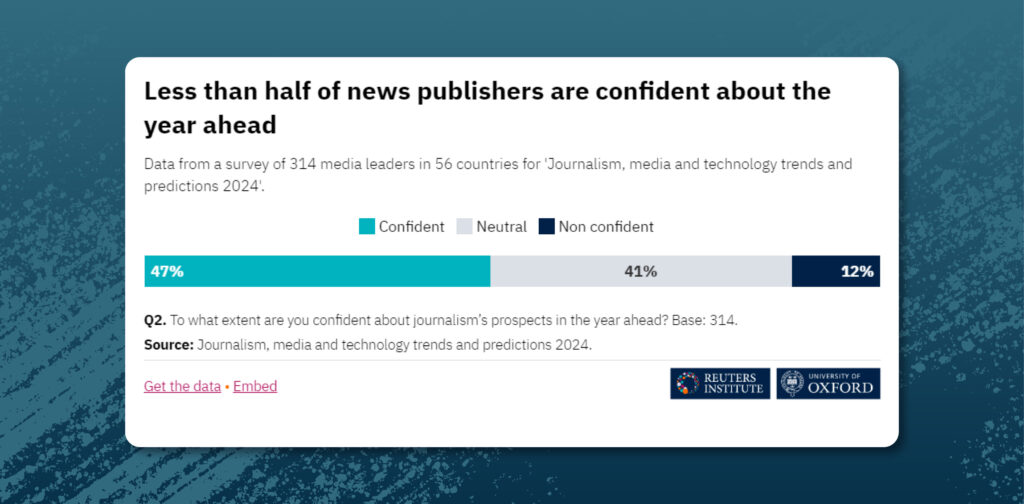
On a positive note, several upmarket publishers can now see a path to sustainable growth from a combination of digital subscriptions and other revenue streams. There are also hopes that a year of major political and sporting events might boost the number of engaged users and help counter audience fragmentation and news avoidance. Nevertheless, there is always a risk that polarised politics will further undermine trust in the news media.
Strong belief in the value of journalism but great uncertainty about the year ahead is the overall sentiment in the survey responses.
Shifts in news and media priorities
Over the past year, evidence indicates that Facebook and similar platforms are giving less priority to news content. Meta, the parent company, is actively countering the rise of TikTok by focusing on incentivising content creators over journalists. The changes at X (previously Twitter), including removing headlines from publisher posts, have significantly reduced its value as an intelligence and traffic source, according to data from Chartbeat.
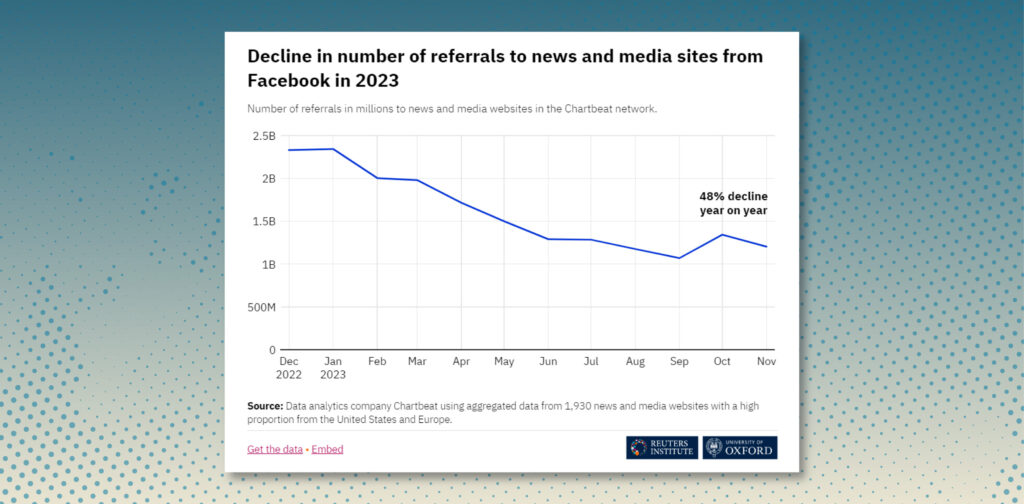
According to Reuters, as traditional social networks decline, two outcomes are evident. Firstly, the negativity surrounding news and political discussions is pushing people towards private messaging apps. Secondly, content-based platforms like YouTube and TikTok are gaining strength, with younger audiences increasingly relying on them for news. The Reuters Institute Digital News Report 2023 highlights the rapid growth of video-based networks globally, where young creators often outshine traditional news organisations. For instance, UK's Dylan Page, a young news creator, has garnered more followers and video views than major outlets, even on significant stories like Gaza.
@dylan.page What do we think about this??🤔
♬ original sound - Dylan Page
Publishers know that if they wish to engage next-generation audiences, they will need to up their game in short-form video. They also think there are opportunities to drive more referrals from messaging services like WhatsApp (+61), business networks like LinkedIn (+41), as well as relatively new sources of traffic such as Google Discover. With the launch of Threads and Bluesky, the job of audience engagement teams has become more demanding than ever.
SGE in the era of artificial intelligence
Google, Microsoft, and others have been exploring new ways of surfacing content known as Search Generative Experiences (SGE). Instead of the traditional list of links, SGE provides direct answers to queries. Microsoft Bing was among the pioneers in integrating real-time news through its collaboration with OpenAI, the creator of ChatGPT. Google has enhanced its capabilities with the introduction of Gemini, a set of multimodal large language models similar to OpenAI's. While Google includes links to the source websites, publishers are concerned about the potential decrease in reasons for users to click on them.
“AI disruption is going to increase business model problems. Search Generative Experience is going to replace some of the media outlets’ functions.”- Chani Guyot, Publisher, RED/ACCIÓN, Argentina
Beyond internet search, expect a surge in conversational AI assistants integrated into computers, mobile phones, and even cars, reshaping how we discover various content. Platforms like Perplexity.ai and Pi.ai are changing the game, allowing users to ask questions, summarise news articles, and engage in coherent conversations on diverse topics. The direction of this trend hinges heavily on decisions from major search providers, especially Google, holding about 90% of the market share.
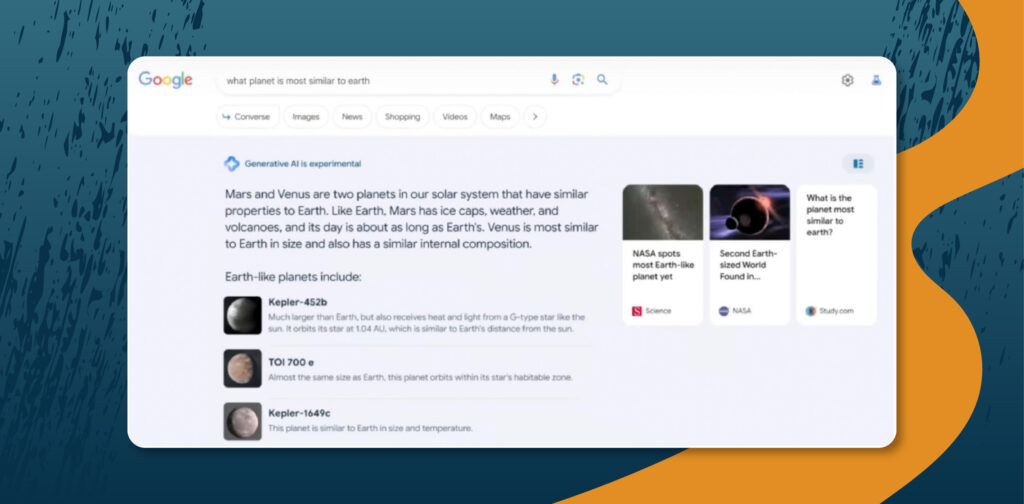
Source: reutersinstitute.politics.ox.ac.uk
Additional turbulence in journalism
The business outlook remains challenging due to advertising market fluctuations and a shift toward digital audiences. In the U.S., over 20,000 media jobs were lost in 2023, six times more than the previous year. Some publishers, especially those adopting paid models, show a positive trend, with continued subscription growth reported in the face of economic challenges. However, the digital revenue increase hasn't fully compensated for declines in print and advertising incomes.
To thrive, media companies must fully embrace digital while still extracting revenue from traditional channels.
Looking ahead, digital subscription and membership (80%) surpass display advertising (72%) as the primary revenue focus for publishers, with most aiming to combine multiple income streams for sustainability.
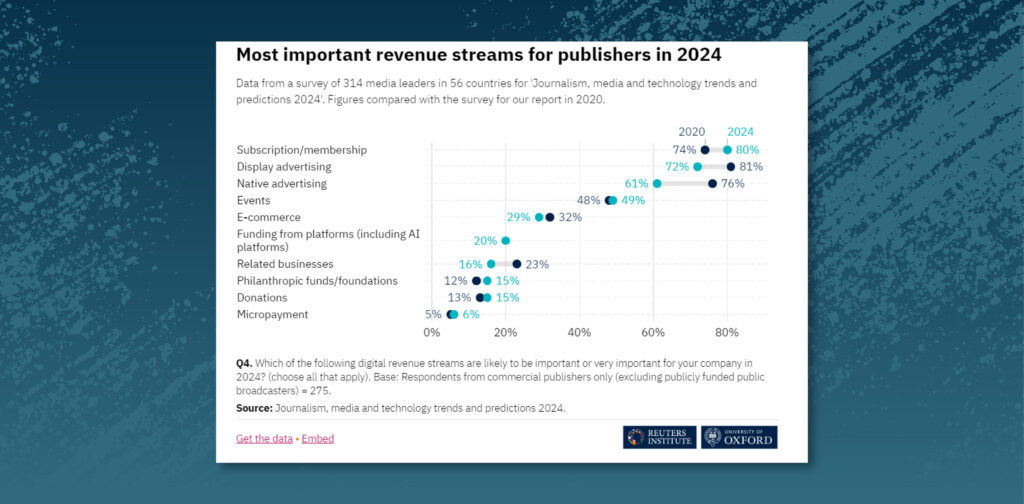
Source: reutersinstitute.politics.ox.ac.uk
What might happen this year?- With subscription growth slowing, most heavy news users already signed up, and churn becoming an increasing burden, we can expect a slew of product and pricing innovations this year:
- It’s all about the bundle- Over the last year, the New York Times has been moving as many of its customers as possible to the ‘all access’ bundle. So far most of these bundles have been intra-company collaborations, but in 2024 we can expect to see some publishers partnering with other providers to add extra value to their bundle.
- Cheaper product extensions- We’re likely to see more upmarket news brands offering ‘lite’ versions this year in an attempt to woo audiences – often younger – that are interested in news but are unwilling or unable to pay the full price.
- Differential pricing- Until recently, most customers paid the same ‘sticker’ price for their news, but as discovered in Reuters recent report on digital subscriptions, that is no longer the case. Once the initial trial discount has run out, publishers are charging a renewal price based on usage (what they think the consumer might pay), or consumers themselves are negotiating a price that works for them.
- Subscription latecomers join the party- All eyes will be on the new CNN CEO Mark Thompson as he attempts to breathe new life into a cable network which has been losing both audiences and revenue. As well as refocusing the core brand, Thompson is expected to launch a number of digital subscription products – just as he did at the New York Times – as well as revamping the CNN Max service, which sits inside Warner Bros’ Discovery streaming service.
The Growing Influence of Audio and Video
The traditional article has been the focal point of online news for the past two decades. However, recent shifts are steering away from this norm. New devices, dedicated platforms for audio and video, and the preferences of younger audiences are driving this change.
The survey indicates a clear trajectory — in 2024, news organisations are leaning towards more video, podcasts, and newsletters, while maintaining a steady output of text articles.
The tide is turning towards multimedia content.
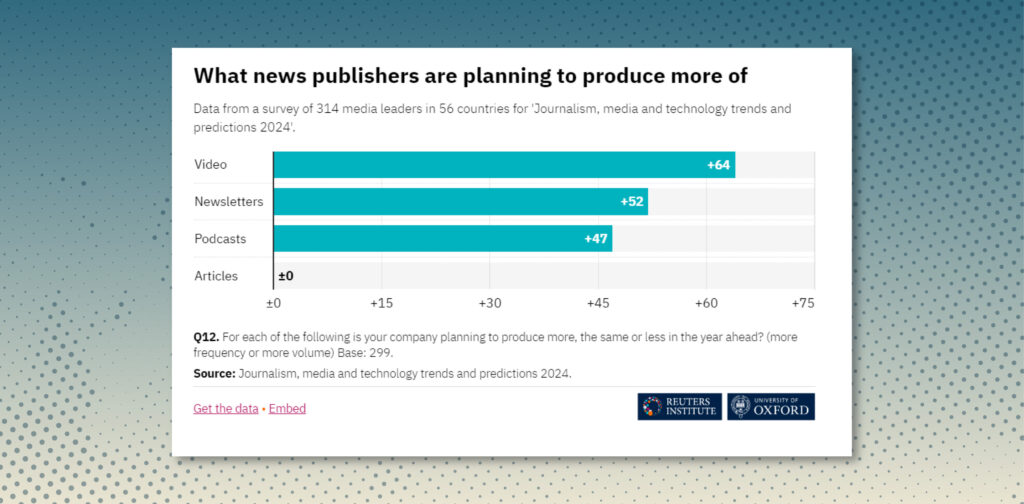
Source: reutersinstitute.politics.ox.ac.uk
What might happen this year in audio and video?
- Vertical video as default - We can expect to see attempts to engage young people with news on platforms where they are spending time, such as TikTok and YouTube Shorts. From a talent perspective, short-form video storytellers will remain in great demand in 2024.
- Podcasts push for visual distribution - Many podcasts are now filmed, which allows them to reach even bigger audiences via platforms such as YouTube. And increasingly, producers have been creating highlight clips, often distributed via TikTok, X, and other platforms.
- Paid podcasts - While podcasts have traditionally been free, we can expect to see a further move to premium and mixed models in 2024. With most big advertisers focused on the top 100 podcasts, those with smaller reach, including many news ones, are finding it harder to pick up revenue.
- Specialist newsletters for a price - Some bigger publishers such as the Financial Times are experimenting with new ways of charging for popular newsletters without having to pay for a full price subscription. In early 2024, the FT will be experimenting with a ‘limited run’ paid newsletter series called Sort Your Financial Life Out
Information fatigue
In 2024, there's a clear trend towards more video, audio, and newsletters. However, not all audiences are seeking additional formats.
Research indicates that news consumers feel overwhelmed by the current array of choices.
The survey reflects a struggle for news organisations to balance business needs and audience interests. Despite recent upheavals, many consumers are disengaging from the news due to information fatigue. Editors acknowledge this challenge, with 67% focusing on better explanations, 44% emphasising solutions, and 43% opting for inspiring human stories. Interestingly, leaders remain cautious about overly positive news (21%) or adopting more entertaining approaches (18%).
“It’s really depressing – I worry that journalism as a business has been too slow to reorient and rethink its role and purpose. People don’t miss journalism. But journalism miss people.”- Lea Korsgaard, Editor-in-Chief, Zetland, Denmark
What might happen this year?
- Letting go of doomsday narratives on climate - Climate change is a subject so profoundly unsettling many have learned to turn away from news coverage in what Wolfgang Blau, Co-Founder of the Oxford Climate Journalism Network (OCJN)19, calls ‘the new climate denial’. Approaches to address this, by providing a sense of hope and personal agency, will gather pace in 2024.
- More diverse reporting perspectives - With traditional war reporters unable to get into Gaza, many of the most compelling eyewitness stories have been told by local residents, including a new generation familiar with tools like Instagram and TikTok. The mainstream media are also looking to expand the range of voices that cover stories.
- Tools to allow audiences to reformat the news - AI-based tools that change the language of news to improve relevance and understanding for particular audiences will be an increasing feature of the news landscape this year. Artifact, for example, is a social news-reading app that can summarise news in different styles.
AI Impact on the Newsroom
Since ChatGPT's public launch a year ago, newsrooms grapple with the implications of AI advancements, particularly generative AI. Despite concerns about trust and intellectual property, publishers recognise AI's potential to enhance efficiency and audience relevance. Survey respondents identify varying levels of risk with AI applications, with content creation deemed the riskiest (56%), followed by newsgathering (28%). In contrast, back-end automation (11%), distribution, and coding are seen as lower risk, prompting a current emphasis on improving back-end efficiencies and exercising caution in robo-journalism ventures.
What might happen this year?
If 2023 was a year for coming to terms with generative AI, this will be the year when newsrooms fully embrace the technologies and incorporate them into workflows.
- AI tools everywhere - This year we can expect to see the emergence of sophisticated AI assistants looking over journalists’ shoulders and suggesting ways of making stories more interesting, more accurate, or more relevant.
- New AI roles and guidelines in the newsroom - Expect to see the appointment of more senior editorial figures to coordinate AI activities and strategy this year. The New York Times recently appointed Zach Seward, previously with Quartz, as its first editorial director of Artificial Intelligence Initiatives. The job description includes establishing how Times journalism can benefit from generative AI technologies, help journalists work faster, and identify guidelines and principles for how the technologies should and should not be applied.
Dangers of AI misuse
As crucial elections approach in over 40 countries in 2024, concerns arise over the potential misuse of new technologies by politicians, activists, and external actors aiming to influence results. These tools rapidly generate synthetic images, audio, and video, allowing targeted micro-campaigns at scale. Electoral regulations have yet to catch up with this threat. Big tech companies like Meta, Google, and TikTok respond by strengthening defenses, requiring AI content disclosures, bolstering election integrity teams, and collaborating with fact-checkers. The Israel/Gaza conflict underscores the widespread use of manipulated images for propaganda across supporters on both sides.

Source: reutersinstitute.politics.ox.ac.uk
Many of the so-called ‘deep fakes’ have been relatively easy to spot so far and only a subset of this content is designed to manipulate or confuse audiences.
Even so, the biggest danger may not be that people ‘believe the lies but rather that nobody believes anything any longer’, as political philosopher Hannah Arendt wrote in the context of an earlier period of upheaval.
New devices and interfaces
In 2024 we’ll see the launch of new devices that aim to break our reliance on the smartphone, using interaction patterns such as voice commands, eye movements, and hand gestures.
Many futurologists think that we are moving towards a world of ‘ambient computing’, where wearable devices process what we hear and see in real time, supported by virtual assistants that can answer questions and serve up contextual information in any language.

Source: reutersinstitute.politics.ox.ac.uk
In this year’s survey, many of the respondents remain deeply sceptical about the idea of smartphone replacement. Four in ten (41%), however, do think that smart speakers and headphones will become a more important interface in the medium term, which partly explains the extra focus on audio.
Conclusion
In conclusion, the rapid pace of technological advancements, particularly in AI, poses challenges for news organisations. While the full implications are yet to be clear, forward-thinking publishers aim to create unique content and experiences that AI cannot easily replicate. Focus areas include curating live news, deep analysis, human experiences, and longer audio and video formats. Simultaneously, leveraging AI for operational efficiency in a challenging economic climate is a priority. News organisations also strive to make journalism more relevant for diverse audiences, addressing issues like low engagement and selective news avoidance. The impact of AI on the wider platform environment remains uncertain, influenced by public attitudes and responsible platform behaviour. Legal cases on intellectual property may shape the use of news content for AI training. Some foresee AI strengthening journalism, while others fear a loss of public trust. As we enter the second year since ChatGPT's launch, we are starting to react and shape journalism in the era of AI.
Read the full Reuters Institute Digital News Report 2024.































